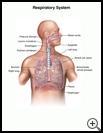
Acute Respiratory Distress Syndrome
________________________________________________________________________
KEY POINTS
- Acute respiratory distress syndrome (ARDS) is a sudden, severe lung problem that causes low levels of oxygen in your blood.
- ARDS is treated in the hospital with oxygen, IV fluids, and medicines.
________________________________________________________________________
What is acute respiratory distress syndrome?
Acute respiratory distress syndrome (ARDS) is a sudden, severe lung problem that causes low levels of oxygen in your blood.
Inside the lungs are tiny air sacs, called alveoli. These sacs help the oxygen you breathe in to get into your bloodstream. ARDS causes a buildup of fluid in the air sacs. The fluid keeps the air sacs from filling with air. This means there is less oxygen in your blood and your body does not get enough oxygen to work properly. ARDS is life-threatening.
What is the cause?
ARDS usually happens when you are seriously ill or severely injured and already in the hospital.
Examples of conditions that can cause it include:
- Drug overdose
- Bacterial infection in the blood
- Pneumonia
- Infection or lung damage from breathing in food, liquid, vomit, or poisons
- Multiple blood transfusions (certain proteins in donor blood may damage the lungs)
- Severe injury to the chest
ARDS usually develops very quickly—within 12 to 48 hours after the event that caused it.
What are the symptoms?
Symptoms may include:
- Fast breathing
- Feeling like you can’t get air into your lungs
- Fast heart rate
How is it diagnosed?
If you are being treated for a severe health problem, your healthcare provider will monitor your breathing and examine you. Tests may include:
- Chest X-ray
- Blood tests
- CT scan, which uses X-rays and a computer to show detailed pictures of the lungs
- An echocardiogram, which uses sound waves (ultrasound) to see how well your heart is pumping
How is it treated?
ARDS is treated in the hospital. Treatment may include:
- Treating the problem that caused the ARDS
- Giving you oxygen. You may need a tube in your throat and a machine to help you breathe.
- Giving you IV fluids and medicines, such as antibiotics to treat infection and inhaled medicines to open up the airway
Your lungs may work normally again after several months. Some people have scar tissue that causes long-term breathing problems. ARDS is a very serious condition and may cause death even with prompt treatment.

